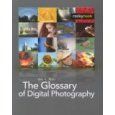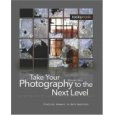
The Glossary of Digital Photography
By John G. Blair
Published: Rockynook
ISBN 978-1-93395-04-8
Paperback, 311 pages, $39.95

Take Your Photography to the Next Level
By George Barr
Published: Rockynook
ISBN 978-1-933952-21-5
Paperback, 199 pages, $43.95
With so many people shooting with digital cameras these days, and discovering and renewing their interest in photography, it’s great to see publishers like Rocynook producing a such a fine line of books on the subject.
Rockynook was founded in 2006 and has produced a couple of dozen books on fine art digital imagery making. They say their “mission is to demystify the cutting-edge developments in digital photography, providing practical instruction to enhance the skills of amateur and professional photographers.” The hand-full of books I’ve seen put out by this publishing house have all been well designed and accessible for reading. The two books under review, Take Your Photography to the Next Level, and The Glossary of Digital Photography, by John G. Blair, are exemplary of the series and are worthy of being on the library shelf any serious photography.
The Glossary of Digital Photography
Now I must admit, I never thought about the need for a glossary book on digital photography. It sounds like a book you’d find in public and college library reference shelves. But the book is printed in paperbound format, so I think Rocynook surely intends that this work won’t gather dust on library shelves. It’s intended for photographers who like to stay abreast of the many technical terms related to both the hardware and software of digital photography. The glossary of over 1500 words, abbreviations, and acronyms defines many terms that we may read or hear about but may not know exactly what they mean. Terms include definitions of words like JPEG, Kelvin, curves, Lab color, and Z-buffer. Typical camera related terms like shutter speed, shutter, ISO, white balance are also, of course, included.
The book is well illustrated with screen shots and photos that help clarify many of the glossary terms. With photos illustrating terms like “memory cards”, “fill flash,” “red eye”, and “levels” this glossary book is clearly intended for both amateur and professional photographers.
While the number of terms are quite extensive, simply reading the definition of particular words won’t always provide you with a real understanding of them. For example, a Photoshop related term like “levels” is defined (in part) in the book as “A function in Photoshop. A histogram of the image displayed, providing a graphical representation of where pixels fall in the range of dark to light. Three triangles are used to set the white point (highlights), middle gray, an dblack point (shadows) of an image….” The definition is accurate and illustrated, but of course you will have to get your hands dirty so to speak in Photoshop to really understand what levels is and how it’s used.
For the most part, John Blair’s definitions are straightforward, with cross referenced terms highlighted in bold. No doubt there are some words that are missing in the book, such as “blur-ray,” but I’m sure words like this will make it in the next edition. Also while the book includes many Photoshop terms like “levels,” “curves,” and “action,” The Glossary of Digital Photography is not intended to cover all of Adobe Photoshop’s related menu items and strategies. Philip Andrews’s A-Z Photoshop books would be more useful if you’re seeking a more definitive collection of terms for Photoshop Elements or Photoshop CS2/3.
No doubt, with the growth and changes in digital photography, Blair will be updating his glossary book for years to come.
Taking Your Photography to the Next Level
I read and referenced at least ten or more digital photography books last year, and I can honestly say that George Barr’s Take Your Photography to the Next Level and Scott Kelby’s 7-Point System are among my top three favorite digital photography books of last year.
Barr is both a family doctor and professional photographer who has been engaged in the craft of photography since he was 12 years old, progressing from medium, 4×5, to DSLR cameras. His images have been published in photography magazines like White Photography, Black and White, Lenswork, and Outdoor Photography (British version.)
Unlike other digital photography books, Take Your Photography to the Next Level is not about choosing the right camera or learning the basic or advance Photoshop skills. Barr’s book is about fine art photography, focusing mainly on abstract, nature, architectural and industrial photography. Writing in a very lucid and learned manner, Barr shares his experiences and skills about reading photographs, composing and assessing images, and taking your photography to the next level.
If you spend any time reading comments on photos posted in Flickr.com, they mainly include the perfunctory words like “great shot,” “beautiful,” “nice shot,” or the “the lighting is beautiful.” Barr observations about what makes a good photograph will take you well beyond these type of comments and evaluations. He provides very helpful outlines about what to look for in a photograph. His second chapter focuses on “working scene,” which is something only serious photographers do. When most people take vacation shots at say the Grand Canyon or Yosemite, they’re typically wide angles shots of a scene, with a family member standing dead center in the photograph. But in taking your photography to the next level, Barr shows you how to work the scene—shooting up close, from different angles. Working the scene includes shooting the same subject in different lighting conditions, finding patterns, assessing the colors and tonal contrasts in a subject, and looking for various ways to compose a shot.
In further chapters, Barr talks about why images fail, and thus what makes a image powerful in the eyes of viewers. The last few chapters includes outlines for identifying and helping you assess your technical and aesthetic skills as a photographer, which provides you a way to figure out where you need to go.
Barr also provides some pointers on dealing with slumps in your photography and breaking into the business of fine art of image making. Nearly every page of Barr’s book includes samples of his high quality images. The last two pages even include information for ordering one or more of Barr’s prints. This does not mean the book is simply a way for Barr to display and sell his work. If you’re serious about taking your photography to the next level, you will get many helpful ideas from reading and applying many of Barr’s observations and suggestions.
The style of writing and layout of Barr’s book makes it very accessible for reading cover-to-cover. I have no serious complaints about this work. I do wonder, however, why he didn’t include a chapter on printing images. Perhaps because this subject addressed in another of Rockynook books, Fine Art Printing for Photographers, by Uwe Steinmueller and Juergen Gulbins.
Take Your Photography to the Next Level is not a complete book of digital photography, nor does it purport to be a definitive work about all types of image making. This book focuses on the type of images you find in art galleries and fine arts books and magazines. What is also great about this book is that you don’t have to spend loads of money to achieve the type of photography that Barr talks about. You can find similar subjects in your own surrounding area.
Barr will inspire you to both re-examine your work and to study many of the great photographers of both film and digital imaging.
To see some of his work, check out his blogsite at http://www.georgebarr.com/.

Leave a Reply
You must be logged in to post a comment.